
Original Article Published in ZDNet Asia, June 29, 2000
by Anita Devasahayam
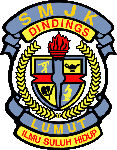 LUMUT, Malaysia: You may not find the Dindings High School, located in the hinterland of Malaysia’s northern state of Perak, on any map, and may pass it by without a second thought.
LUMUT, Malaysia: You may not find the Dindings High School, located in the hinterland of Malaysia’s northern state of Perak, on any map, and may pass it by without a second thought.
But located within its wooden walls and under zinc roofs are budding entrepreneurs of the new dot-com world.
The 800 students of the school, ranging in ages between 13 and 17, surf the Internet, learn Web design, digital art, networking, and programming in C, Visual Basic, Linux and Unix as part of their daily curriculum.
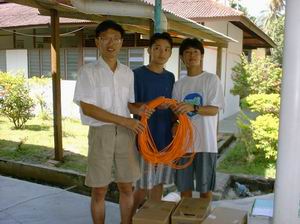
In their most recent school project, a group of 20 students received hands-on experience in laying a one-km 10Mbps fiber-optic cable to inter-link the school with a nearby primary school and kindergarten. The campus-wide high-band network was probably the first of its kind in the country that was commissioned and maintained by teenagers. The new link-up will enable students and teachers to experiment with classroom-to-classroom video-conferencing and other multimedia applications.
“By the time these students leave school, they will have enough technical know-how and skills to configure and use switches and hubs and manage networks,” said principal Tiong Ting Ming who is the driving force behind the rural school’s transformation.
Eight years ago, the radical 48-year-old principal, was assigned to the Dindings school located near the beachfront town of Lumut, where the community’s lives are mostly centered around trading, fishing and agriculture.
Tiong had come with the belief that the textbook-reliant, exam-oriented education system the school was governed by was not enough to equip his students to participate in a globalized economy. Added to that the less-motivated students were dropping out and he needed to stem the tide.
An Apple Macintosh fan, Tiong was switched on by the opportunities that computing technology could give his young charges. “One of the hardest things was convincing some of the more skeptical parents and technophobic teachers that computers are necessary to give the kids skills they could use in the real world,” he said.
When the Internet came along, it served to reinforce Tiong’s belief that he needed to arm his students for the future knowledge workplace. “The Internet is their future. I was convinced educating them to be responsible Net citizens and giving them the right skill sets had to start in school,” he said.
Persistence pays
A chemistry graduate, Tiong set about teaching himself to repair and upgrade old PCs and cajoled teachers and students to embrace the Internet. Only partially supported by government and without the cash-rich opportunities of urban schools, Tiong knocked on doors of corporations and benefactors to win them over.
“I visited one company in Kuala Lumpur seven times before they finally relented and gave me the first set of PCs and Macs to get us started,” said Tiong.
He also travelled personally on 800-km bus journeys to-and-fro Singapore to purchase spare parts to refurbish second-hand computers for his students. “Computer parts are expensive in Malaysia and are much cheaper from bargain hardware purveyors at Sim Lim Square in downtown Singapore,” he said.
With the aid of former-students, some generous individual donors, various companies, and the Ministry of Education, the school has since raised over 1.8 million ringgit (US$470,000), in cash and kind, to fund its efforts to build up a networked environment from scratch.
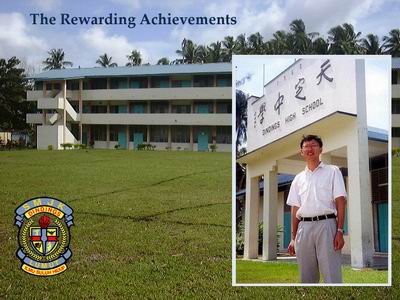
Wedged between a palm oil estate and a coconut plantation, the school now boasts a brand new three-storey block that is a hive of computing activity. Tiong’s office is more akin to a computer retail shop’s back-office, and is packed with an assortment of PCs, servers, peripherals, cables and an over-laden shelf filled with phonebook-sized technical manuals and books.
His open-door policy, during this interview, saw busy students come in armed with some component or another, then skitter off spouting geekspeak. Amid the clutter in the room there is even a bed to get some shut-eye and a fridge for snacks when his students are working on late-night “projects.”
One of those projects, administered by Tiong, was the wiring of the entire school including the classrooms, the library, the staff room, the administration office and computer labs.
The school now has over 100 PCs – 486s, Pentium 75s and Pentium MMX 166s – that give students and teachers instant access to the Internet via a 64Kbps leased line.
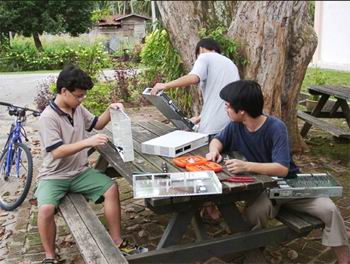
A cadre of trained students upkeep the PCs and administer the Dell 553MHz dual -processor main server, and a self-configured secondary and backup server.
The Red Hat Linux 6.1 powered-server houses their mail server, Apache Web server, proxy server, newsgroups, Internet Relay Chat, and file, print and backup server.
‘I chose Linux because the system cost me only 200 ringgit and was useful for my students to learn and configure,” he said.
Sowing the Net generation
Early last year, Tiong yanked biology as a subject from the curriculum for his Form Four (16-year-old) students and replaced it with information technology. “Better to know the innards of a computer than human or animal anatomy,” he thought.
He has since extended the subject school-wide, and all students have their own individual email and attend varied courses ranging from basic software to hardware troubleshooting and maintenance, programming, local area networking, and structured cabling and certification.
Students are also assigned projects by teachers to encourage them to do research on the Internet to complement their traditional subjects.
This year, a pioneer batch of 120 students will be taking Information Technology as an exam subject for the year-end compulsory government examinations, that is a prerequisite for university entrance.
Networking giant 3Com Corp adopted Dindings as the first of 11 schools in the country for its global NetPrep program to provide students with network management skills.
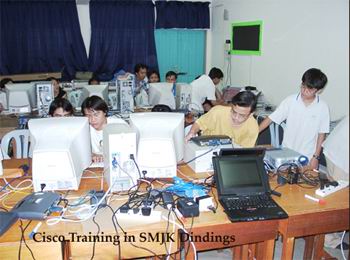
The first batch of 20 students are currently undergoing 160-hours of the intensive program and will be certified by the International Association of Communication Systems Engineers upon completion.
Tiong believes the hard work has begun to pay off. “I used to have to persuade parents to keep their children in school. Now I get queries from far and wide to have their children sent here,” he said. The student population has grown steadily, in tandem with the school’s computing firepower, from 320 to the present 800.
He discloses that school’s passing rate in year-end exams, a government barometer for a school’s success, is still only around 50 percent. “But their environment is sheltered. Introducing the Internet to the students has opened their minds tremendously and given them insights and the motivation to be discerning and analyze information,” he said.
Tiong said his ultimate goal is to provide an environment where the “Net culture” can thrive. He hopes students can be imprinted with a self – and life-long learning trait that they could retain beyond school walls.
He added that teachers in the country need to bone up to adapt to the rapidly shifting educational needs of students. “Teachers are at risk of becoming obsolete if they do not understand nor accept that they no longer hold a monopoly over the input their students receive. They must become as Net-savvy as their students. You can ignore the technology, but not the information,” he said.
Tiong is convinced the information technology skills his students acquire will equip them for life in the real working environment and to be more responsible with the use of the technology. It may even inspire some to become entrepreneurs. As Tiong puts it: “You can either be a paddy planter or rice eater. I am teaching my kids to be planters because that’s their future ricebowls.”

Published in ZDNet Asia
by Anita Devasahayam